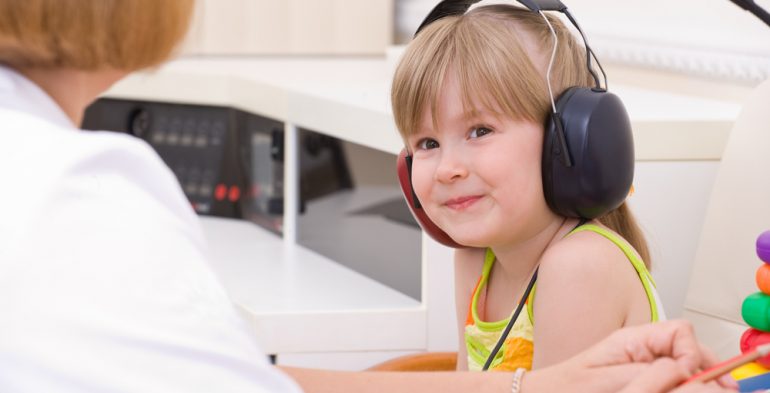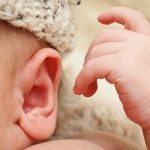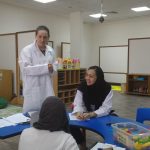
Jeddah Institute for Speech and Hearing (JISH)
Hearing is an important mechanism. We only realize how important it is when weare deprived of. Until recently, it was commonly believed that those who cannot hear could not speak as well. Nowadays, however, this concept has changed, as with using the appropriate hearing aid devices and receiving rehabilitation services, most hearing-impaired people can understand speech and communicate orally with others.
Our experience as a leading center in the field of communication disorders has taught us that no rehabilitation program can succeed without pursuing treatment at home. This concept is even more important if the person suffering for hearing impairment is a child, as parents take the bigger role to ensure hearing aids are working properly and provide him/her with the necessary hearing skills, to facilitate language acquisition and match peers with normal hearing. For parents to meet their duty in the rehabilitation process, they should first be aware of key principles of aural-oral rehabilitation and milestones the child should pass before he/she can communicate orally with others.
JISH Aural/Oral Rehabilitation Unit:
Children with hearing impairment need rehabilitation programs that can promote the development of hearing and listening skills necessary for the normal acquisition of language like their peers with normal hearing. Such programs are known as Aural/Oral Rehabilitation programs. Despite their superficial differences, they all focus on developing hearing and listening skills in the hearing impaired child to facilitate his/her language acquisition process.
What is Aural/Oral Rehabilitation?
The concept of Aural/Oral Rehabilitation emerged as a result of scientific and technical advancements in the field of hearing impairment treatment, where it was crucial for rehabilitation and therapy techniques to be in line with these advancements. The great advances made in hearing aid technology and in cochlear implant surgeries have now provided many hearing impaired children with the opportunity to receive this kind of rehabilitation. Using hearing aids or cochlear implant surgeries (or both), most hearing impaired children can hear and communicate orally with others, which is what oral rehabilitation is based on.
Supporters of aural/oral rehabilitation believe that reliance on hearing and using speech to communicate can help hearing impaired childrenblend more effectively with society and educational system.This principle is especially important in the Middle East, because there is no other viable option for communication, for example, there is no established universal Arabic sign language to be used by hearing-impaired children in learning or communicating yet.
However, Aural/oral communication is not the only communication method available for the hearing impaired; other methods include using total communication, which uses gestures (signs), lip reading and writing, or whatever is available to communicate with other.Sign language is another method for communication; however, as mentioned earlier, sign language has not been unified in the Middle East such as the American Sign Language (ASL). Total communication and sign language are the treatment of choice when the child fails to benefit from the hearing aids or when the child’s parents cannot adapt to the aural/oral rehabilitation program requirements.
Key Principles of Aural/Oral rehabilitation:
This part addresses the fundamental principles of Aural/Oral Rehabilitation, i.e. the use of oral language, early diagnosis, parents’ cooperation, treatment sessions, speech development through hearing, integration of learning and living environment, stimulation of hearing skills, constant evaluation, and encouraging children to depend on themselves in communication.

One: Encourage the child to use oral language to communicate. To achieve this, we must talk to the child and not use visual communication methods such as gestures and signs; as these are not part of the aural/oral method.
Two: Encourage identifying hearing loss as early as possible andproviding the child with the appropriate hearing aids, FM device, or to have the child undergo cochlear implant surgery, to enable the child to learn how to hear and speak in the early years of his/her life. That is why no time should be wasted in providing the child with the ability to hear. The appropriate hearing aids are chosen on an individual basis for each case to enhance the child’s ability to hear others while speaking and learn to speak. This is where the audiologist and ENTspecialist (when necessary) join handsto achieve the maximum hearing level for the child.
Three: Develop a partnership between parents and the therapist to train parents on how to provide the best oral learning opportunities for their child, through communicating with the child orally, encouraging others to follow their example, and preventing them from using wrong communication methods with their child (such as using “soundless” talking, whispering,using gestures or shortened sentences, etc.).
Parents will also be required to attend therapy sessions with their child to receive guidance and advice on methods that can be used to teach their child to talk within the natural household and social environments. Parents, rather than the aural/oral specialist or hearing impaired teacher, are the main source of learning for the child.Parents also learn how to use various opportunities in a child’s life to develop his/her listening and speaking skills.
Four: Each child and his/her parents receive individual therapy sessions in which an individual therapy plan is designedto meet the child’s specific needs. The role of the aural therapist is restricted to training, guiding andadvising parents until listening and speaking become natural for their child. Each child and family have unique and different needs, which is why they are addressed individually.
Five: Develop the child spoken language through listening and hearing. During this process, the hearing-impaired child learns to listen to his/her own voice, and to imitate the speech of those around in the same manner as normal hearing children do. The child begins to coo, then to babble, then to approximate the sound of words, and eventually progressesto

single words and sentences. The child is not directly trained to lip read, however, he/she develops this skill naturally from daily exposure to spoken language and observing facial expressions of speakers.
Six: Natural living and learning environments should be combined in a way that enables the child to learn daily chores, recreational activities, hopes and aspirations of the family. Parents are also encouraged to treat their hearing impaired child similarly to their other children.
Seven: Motivate and guide the child through the natural developmental milestones necessary for the acquisition of hearing, speech and language skills. The aural/oral rehabilitation program focuses on teaching the child to be attentive to different sounds that stimulate the areas of the brain that process hearing, language acquisition and oral communication. As the child’s ability to discriminate between sounds and his/her auditory memory improve, his vocabulary, phrases, and sentences begin to expand. Parents are encouraged to use daily events to reinforce the child’s listening and language skill. The child’s first years of hearing are crucial to establish the listening and hearing foundations necessary for oral communication.
Eight: Technological and therapy needs of a hearing-impaired child can change over time. Iit is,therefore, important to evaluate and monitor his/her needs constantly, which is why therapy is seen as continuous diagnosis process where information about the child level and needs are collected and discussed with parents and the treatment program is adjusted accordingly.
Nine: Train the child to depend on himself/herself in communication and encourage him/her to socialize and learn. By making friends with normal hearing children and going to normal hearing children preschools and

schools, the child is provided with oral communication models and made familiar with what is socially required of him/her.
Key requirements for the success of the Aura/Oral Rehabilitation Program:
The success of the aural/oral Rehabilitation Program depends on the availability of a hearing environment, the proper implementation of the rehabilitation program and family engagement.
- The hearing environment:
In aural/oral rehabilitation programs, the child learns spoken language through listening and hearing, and not through seeing. Therefore, it is natural that the training takes place in an environment that encourages listening to facilitate understanding information, which in turn promotes learning.To encourage listening:
- Sit in close proximity to the child (on the side of the better ear)
- Talk from a close proximity to the child’s hearing aid or his/her cochlear implant
- Talk to the child naturally (avoid shouting or whispering)
- When talking to the child, avoid sitting in an area where there is background noise (television, air-conditioning etc.)
- Use tones rich in intonation, rhythm, and expressive elements(such as using a happy, sad or angry tone, etc.)
- Use acoustic highlighting (emphasize the incomprehensible word by pronouncing it louder or using a different tone than the rest of the sentence).
- The treatment program:
The aural/oral rehabilitation sessions are usually diagnostic and provide guidance, used to evaluate both the child and parents’ progress and skills. During these individual sessions, the therapist assesses each child and his/her family specific needs individually. These sessions can take place in clinics or schools. The therapist can use the child’s own toys or small figures to encourage conversation with the child through listening and hearing.
Most aural/oral rehabilitation sessions are an hour to an hour and a half long weekly, which is why the parents’ participation is essential to the success of the program.Through their encouragement and guidance, parents develop confidence to implement the necessary strategies and techniques to reach the goal. Oral rehabilitation therapist outlines, guides and trains parents to help their child achieve the maximum use of his/her aural abilities. In addition to these individual sessions, the child might also attend group sessions to achieve specific goals, such as learning to communicate appropriately with his/her peers, amongst others.
Together as a team, the parents and the therapist set specific goals for the child to work on at home. For young children, these goals include playing with toys, performingdaily household activities. For older children, they includestorytelling, developing speaking and listening skills in noisy environments and learning topics relevantto school curriculum. All these goals depend on the child development and hearing skill levels. These

hearing and listening skills are developed through play, daily routine activities as well as oriented activities and songs.
- Parents engagement:
Aural/Oral Rehabilitation philosophy is based on the point of view that children learn language more easily when they interact with people they have a bond with (i.e. their parents in their homes, and while taking part in activities that they enjoy and that are meaningful for them in a comfortable and secure environment). For that reason, parents observation and participationin sessions are very importantfor the following reasons:
- Provide the best models of communication to use with the child to promote hearing and language and communication activities at home to be followed by others.
- How to plan introducing hearing, listening, speech and language to their child’s daily activities .
- Communicate with therapists as partners in the rehabilitation of their child.
- Inform the therapist about their child’s interests and abilities.
- Ability to understand the meaningoftheir child’s first attempts to communicate.
- Develop methods to deal with any concerns they may have about their child’s behavior.
- Record and discuss their child progress.
- Understand the short-term and long-term goals of the treatment plan.
- Develop self confidence to deal with their hearing impaired child.
- Make informed decisions.
- Protect the rights of their child (for example:preventing others from using signs and gestures instead of spoken language with their child).
Factors affecting progress:
Children and their families have different learning styles and lifestyles. As a result, hearing and communication development level varies from one child to another, and their progress often depends on several factors, such as:
- Childage when first diagnosed with the hearing impairment.
- The earlier the hearing loss is discovered the better the prognosis.
- Cause(etiology) or the type of hearing loss.
- Severityof the hearing loss.
- Efficacyof the hearing aids or cochlear implant.
- Efficacyof the audiology services provided(hearing aids software, etc.)
- Childgeneral health.
- Emotionalwellbeing of the child’s family.
- Level of parents engagement.
- Levelof proficiency of the therapist.
- Parents’ skills.
- Childindividual learning style.
- Childcognitive ability.
- Cooperation of the child’s surrounding environment (his friends and family).








